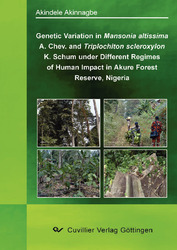| Fachbereiche | |
|---|---|
| Buchreihen (96) |
1377
|
| Nachhaltigkeit |
3
|
| Gesundheitswesen |
1
|
| Geisteswissenschaften |
2361
|
| Naturwissenschaften |
5403
|
| Mathematik | 229 |
| Informatik | 318 |
| Physik | 979 |
| Chemie | 1362 |
| Geowissenschaften | 131 |
| Humanmedizin | 243 |
| Zahn-, Mund- und Kieferheilkunde | 10 |
| Veterinärmedizin | 108 |
| Pharmazie | 147 |
| Biologie | 835 |
| Biochemie, Molekularbiologie, Gentechnologie | 121 |
| Biophysik | 25 |
| Ernährungs- und Haushaltswissenschaften | 45 |
| Land- und Agrarwissenschaften | 1004 |
| Forstwissenschaften | 201 |
| Gartenbauwissenschaft | 20 |
| Umweltforschung, Ökologie und Landespflege | 148 |
| Ingenieurwissenschaften |
1788
|
| Allgemein |
97
|
|
Leitlinien Unfallchirurgie
5. Auflage bestellen |
|
Erweiterte Suche
Genetic Variation in Mansionia altissima A. Chev. And Triplochiton scleroxylon K. Schum under Different Regimes of Human Impact in Akure Forest Reserve, Nigeria
Akindele Akinnagbe (Autor)Vorschau
Inhaltsverzeichnis, Datei (32 KB)
Leseprobe, Datei (130 KB)
Humans have exploited forests for thousands of years as they seek to use forest species as
resources for food, fuel and timber, or to clear forested land for agricultural and urban purposes.
In modern times, forests exposed to intensive human disturbance are the species-rich tropical
forest ecosystems. For instance, Nigeria has the world’s highest deforestation rate of primary
forests. Between 2000 and 2005, 55.7 percent of primary forests in the country, defined as
forests with no visible signs of past or present human activities, were lost as a result of human
activities such as logging, subsistence agriculture, and the collection of fuelwood. Since genetic
diversity within species is crucial for their long-term survival, conservation of genetic diversity
in tree species should be given high priority. For effective conservation of genetic diversity in
tree species in a country where prevalent human activities are shrinking its forests, effects of
human activities on genetic diversity in tree species need to be analysed.
This dissertation aims at analysing and comparing effects of human impacts on genetic diversity
in Mansonia altissima A. Chev. and Triplochiton scleroxylon K. Schum. Mansonia altissima and
Triplochiton scleroxylon are important West African timber tree species of family Sterculiaceae
with contrasting successional status. Mansonia altissima is a non-pioneer light demanding tree
species, characteristically more abundant in closed forests, whereas Triplochiton scleroxylon is a
pioneer species predominant in open forests. Since human disturbances tend to have opposite
impacts on the regeneration potential of these two species, also different effects on genetic
diversity levels were expected. Fresh leaves of adult trees and saplings of both species were
collected from the same plots in Akure Forest Reserve, Nigeria namely: an isolated forest patch,
a logged forest and a primary forest with no visible signs of past or present human activities.
Additionally, samples were collected from a plantation for M. altissima and a farmland
population for T. scleroxylon. DNA isolated from the leave samples was analysed by Amplified
Fragment Length Polymorphism (AFLP) markers.
The result showed that the pioneer species Triplochiton scleroxylon (He = 0.267; PPL = 63.1; Br
= 1.450) is by far more variable than the non-pioneer light demanding species Mansonia
altissima (He = 0.045; PPL = 16.8; Br = 1.162). With regard to the effect of human impact on the
genetic diversity, contrasting results were obtained for the two species. For Mansonia altissima,
the highest diversity was observed in the Primary Forest (He = 0.062; PPL = 21.0; Br = 1.204),
while the lowest estimate was found in the isolated forest patch (He = 0.032; PPL = 9.0; Br =
1.089). Conversely, for Triplochiton scleroxylon, the diversity estimates were lowest in the
primary forest (He = 0.249; PPL = 59.1; Br = 1.211) and highest in the isolated forest patch (He =
0.277; PPL = 67.2; Br = 1.625). Genetic differentiation among populations in the two species
was weak (Mansonia altissima ΦST = 0.039; Triplochiton scleroxylon ΦST = 0.041). In the
spatial genetic structure analyses, a significant spatial genetic structure was found only in logged
and isolated patch populations of Mansonia altissima.
In the context of other studies, it can be assumed that tropical non-pioneer tree species are likely
to show a lower genetic diversity than tropical pioneer species. In addition, results from this
study suggest that non-pioneer tree species might be more susceptible to genetic erosion due to
adverse human impacts than pioneer tree species. From a conservation point of view, the low
genetic diversity in Mansonia altissima suggests that the maintenance of genetic diversity in M.
altissima requires urgent attention, and the scale of human impact in the study area could pose a
serious threat to the future viability of Mansonia altissima if no conservation measures are taken.
| ISBN-13 (Printausgabe) | 3867277516 |
| ISBN-13 (Printausgabe) | 9783867277518 |
| ISBN-13 (E-Book) | 9783736927513 |
| Buchendformat | A5 |
| Sprache | Englisch |
| Seitenanzahl | 114 |
| Auflage | 1 Aufl. |
| Band | 0 |
| Erscheinungsort | Göttingen |
| Promotionsort | Universität Göttingen |
| Erscheinungsdatum | 19.09.2008 |
| Allgemeine Einordnung | Dissertation |
| Fachbereiche |
Forstwissenschaften
|








